
An altar is a structure upon which offerings such as sacrifices are made for religious purposes. Altars are found at shrines, temples, churches and other places of worship. They are used particularly in Paganism, Christianity, Buddhism, Hinduism, Judaism, and Modern Paganism. Many historical faiths also made use of them, including the Roman, Greek, and Norse religions.

Saint Joseph's Day, also called the Feast of Saint Joseph or the Solemnity of Saint Joseph, is in Western Christianity the principal feast day of Saint Joseph, husband of the Virgin Mary and legal father of Jesus Christ celebrated on 19 March. It has the rank of a solemnity in the Catholic Church. It is a feast or commemoration in the provinces of the Anglican Communion, and a feast or festival in the Lutheran Church. Saint Joseph's Day is the Patronal Feast day for Poland as well as for Canada, persons named Joseph, Josephine, etc., for religious institutes, schools and parishes bearing his name, and for carpenters. It is also Father's Day in some Catholic countries, mainly Spain, Portugal, and Italy. It is not a holy day of obligation for Catholics in the United States.
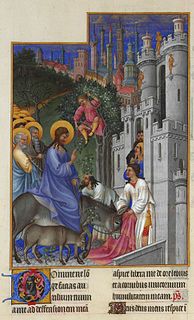
In some traditions of Christianity, Holy Week is the most sacred week in the Church year. In Eastern Rite Churches, also known as Eastern Orthodox, Holy Week occurs the week after Lazarus Saturday and starts on the evening of Palm Sunday. In the rites of the Western/Latin/Roman Church it begins with Palm Sunday and concludes on Easter Sunday. For all Christian traditions it is a moveable observance. In Eastern Rite Churches, Holy Week starts after 40 days of Lent and two transitional days, namely Saturday of Lazarus and Palm Sunday. In Western Rite Churches, Holy Week falls on the last week of Lent or Sixth Lent Week.

Holy Saturday, also known as Great and Holy Saturday, the Great Sabbath, Hallelujah Saturday, Saturday of the Gloria and Black Saturday or Easter Eve, and called "Joyous Saturday" or "the Saturday of Light" among Coptic Christians, is the final day of Holy Week, between Good Friday and Easter Sunday, when Christians prepare for the latter. The day commemorates the Harrowing of Hell while Jesus Christ's body lay in the tomb. Christians of the Catholic, Lutheran, Methodist, Anglican and Reformed denominations begin the celebration of the Easter Vigil service on Holy Saturday, which provides a transition to the season of Eastertide; in the Moravian Christian tradition, graves are decorated with flowers during the day of Holy Saturday and the celebration of the sunrise service starts before dawn on Easter Sunday.

The Paschal Triduum or Easter Triduum, Holy Triduum, or the Three Days, is the period of three days that begins with the liturgy on the evening of Maundy Thursday, reaches its high point in the Easter Vigil, and closes with evening prayer on Easter Sunday. It is a moveable observance recalling the Passion, Crucifixion, Death, burial, and Resurrection of Jesus, as portrayed in the canonical Gospels.

The Antimins, is one of the most important furnishings of the altar in many Eastern Christian liturgical traditions. It is a rectangular piece of cloth of either linen or silk, typically decorated with representations of the Descent of Christ from the Cross, the Four Evangelists, and inscriptions related to the Passion. A small relic of a martyr is sewn into it.

Easter Vigil, also called the Paschal Vigil or the Great Vigil of Easter, is a liturgy held in traditional Christian churches as the first official celebration of the Resurrection of Jesus. Historically, it is during this liturgy that people are baptized and that adult catechumens are received into full communion with the Church. It is held in the hours of darkness between sunset on Holy Saturday and sunrise on Easter Day – most commonly in the evening of Holy Saturday or midnight – and is the first celebration of Easter, days traditionally being considered to begin at sunset.
Dedication is the act of consecrating an altar, temple, church, or other sacred building. It also refers to the inscription of books or other artifacts when these are specifically addressed or presented to a particular person. This practice, which once was used to gain the patronage and support of the person so addressed, is now only a mark of affection or regard. In law, the word is used of the setting apart by a private owner of a road to public use.
An altar stone is a piece of natural stone containing relics in a cavity and intended to serve as the essential part of an altar for the celebration of Mass in the Roman Catholic Church. Consecration by a bishop of the same rite was required. In the Byzantine Rite, the antimension, blessed and signed by the bishop, serves a similar function.
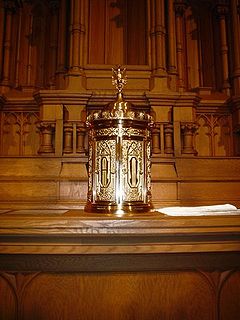
For those Christian traditions who practice the rite known as Communion or Holy Communion, a tabernacle is a fixed, locked box in which the Eucharist is "reserved" (stored). A container for the same purpose, which is set directly into a wall, is called an aumbry.

The Holy Qurbana, refers to the Eucharist as celebrated in East Syriac Christianity. This includes various descendants of the Church of the East. East Syriac Christianity consists of Edessan liturgical rite, the East Syriac Rite. The major Anaphora of the East Syriac tradition is the Holy Qurbana of Saints Addai and Mari. The Churches are primarily based in the Middle East, Africa, and India.

An altar cloth is used in the Christian liturgy to cover the altar. It is both a sign of awe as well as decoration and protection of the altar and the sacred vessels. In the orthodox churches is covered by the antimension, which also contains the relics of saints.
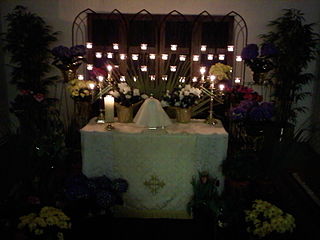
The altar of repose is an altar where the Communion hosts consecrated on Maundy Thursday during the Mass of the Lord's Supper are placed, or "reserved", for use on the following day, Good Friday. The altar can be found in Roman Catholic, Old Catholic, Anglican, and some Lutheran churches. Good Friday is the day on which the death of Christ is observed. His Resurrection is not observed until Easter Sunday and the anticipatory Easter Vigil on Holy Saturday. Between the time of his death and resurrection, mass is not celebrated, and so communion hosts cannot be consecrated. Any hosts used on Good Friday must have been consecrated previously.

The Mass of the Lord's Supper, also known as A Service of Worship for Maundy Thursday, is a Holy Week service celebrated on the evening of Maundy Thursday. It inaugurates the Easter Triduum, and commemorates the Last Supper of Jesus with his disciples, more explicitly than other celebrations of the Mass.

The corporal is a square white linen cloth, now usually somewhat smaller than the breadth of the altar, upon which the chalice and paten, and also the ciborium containing the smaller hosts for the Communion of the laity, are placed during the celebration of the Catholic Eucharist (Mass).

An altar crucifix or altar cross is a cross placed upon an altar, and is often the principal ornament of the altar.
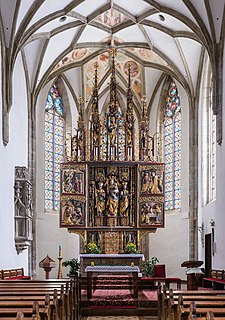
In the Catholic Church, the altar is the structure upon which the Eucharist is celebrated.
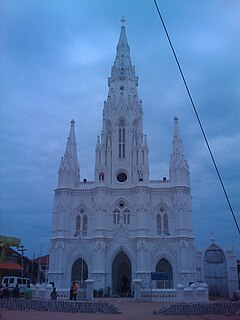
Our Lady of Ransom Church is a Catholic church located at Kanyakumari, Tamil Nadu, India.

St. Jude Syro Malankara Catholic Church is a parish of the Syro-Malankara Catholic Eparchy of the United States of America and Canada located in Bensalem, Pennsylvania, US. St Jude celebrates Qurbono in Malayalam and English and serves members of the Syro-Malankara Catholic Church in the Delaware Valley.

Kattachira is a church in the Kollam Diocese of the Jacobite Syrian Christian Church. In this church, aromatic oil flowed from the Icon of the Mother of God.

















